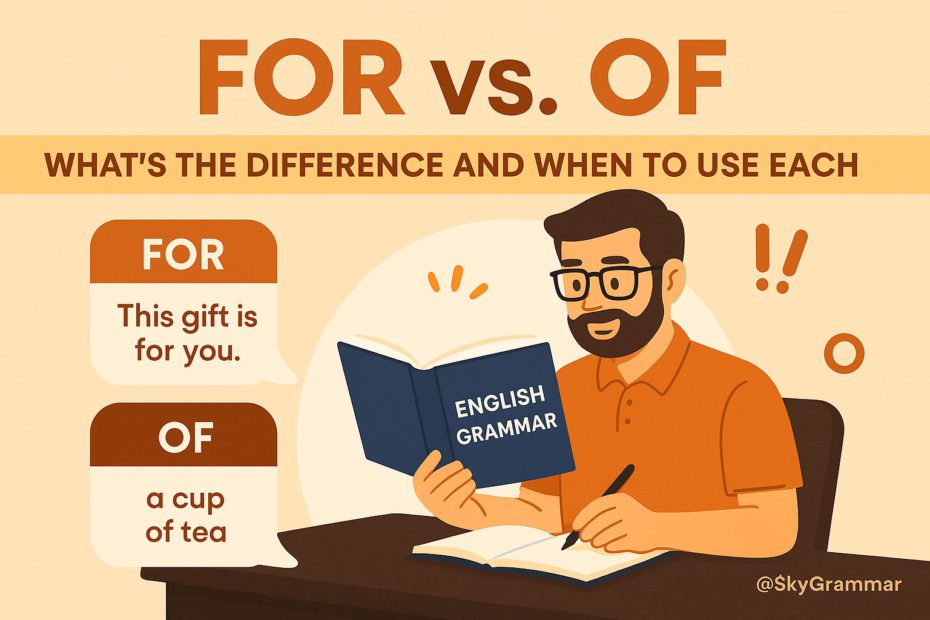In English, prepositions are small words that carry a lot of meaning. Among the most commonly used—and often confused—are “for” and “of.” Both are used in a wide range of expressions, and choosing the wrong one can change the meaning of a sentence or make it sound unnatural. In this guide, we’ll break down the difference between “for” and “of,” explore their uses, and provide plenty of examples to help you use them correctly in everyday writing and speech.
🔍 Understanding the Basics
Before diving deeper, let’s explore the definitions of both words:
- For typically indicates purpose, benefit, duration, support, or destination.
- Of generally shows possession, origin, composition, or association.
While that may seem simple, things get a bit more complex when we look at how these prepositions are used in different grammatical contexts.
📌 When to Use “For”
“For” functions as a preposition that indicates purpose, benefit, or intended recipient. It often explains why something is done or who it is meant to help.
1. Purpose or Function
Use “for” to indicate the purpose or goal behind an action or object.
- This tool is for cutting wood.
- I made this gift for you.
- The vitamin is for stronger bones.
In each case, “for” explains why something exists or what it’s used for.
2. Benefit or Recipient
Use “for” when referring to the person or thing that benefits from an action.
- She baked cookies for her classmates.
- Is this seat for Mr. Anderson?
- I’ll do the dishes for you.
3. Duration of Time
“For” can also indicate the duration of time something continues or is expected to continue.
- They have been married for 20 years.
- We stayed in Paris for a week.
Note: Don’t confuse this with “since,” which is used for starting points in time.
4. Support or Favor
Use “for” to indicate agreement or support.
- Are you for or against the new policy?
- I voted for her because I trust her vision.
5. Destination or Direction
In some contexts, “for” points toward a goal or movement.
- They left for London early in the morning.
- This package is for the marketing department.
📌 When to Use “Of”
“Of” shows relationships between parts, especially possession, origin, or content. It is used to express possession, connection, or to provide additional detail about something.
1. Possession or Belonging
This is the most common use of “of”—showing that something belongs to something else.
- The legs of the chair are broken.
- The color of the sky is beautiful.
- The home of the president is heavily guarded.
In these cases, “of” can often be replaced with an apostrophe + s (’s) when referring to people or animals:
- The president’s home.
- The chair’s legs.
However, we typically use “of” for things or abstract ideas.
2. Composition or Content
Use “of” to describe what something is made of or contains.
- A bottle of water.
- A piece of cake.
- A slice of pizza.
You’re naming a part or content of something larger.
3. Origin or Source
” Of “ can also indicate origin or source, revealing where something or someone comes from.
- A man of great intelligence.
- Citizens of Pakistan.
- The University of Oxford.
This helps identify people, places, and institutions.
4. Subject or Quality
Sometimes “of” is used to describe an abstract quality or subject.
- A matter of importance.
- A feeling of sadness.
- An act of kindness.
Here, “of” links a specific quality or action with its subject.
❗ Common Confusions Between “For” and “Of”
Because both words can relate two ideas or items, English learners often confuse when to use which. Let’s compare some examples to show the difference:
❌ Incorrect:
- A list for items.
- The benefits for the plan.
✅ Correct:
- A list of items. (Content)
- The benefits of the plan. (Possession or relationship)
✅ Correct use of “for”:
- I brought flowers for my friend. (Recipient)
- A campaign for clean water. (Purpose)
In these examples, “of” focuses more on what something is made up of or associated with, while “for” talks about who or what benefits from something, or why it is done.
🔁 Can You Use Both?
Sometimes, both “for” and “of” could grammatically work, but the meaning changes.
Example:
- “The manager of the team” — shows who leads the team.
- “The manager for the team” — suggests someone working on behalf of or in support of the team.
Another:
- “The gift of music” — describes music as a valuable trait or talent.
- “A gift for music” — means someone has a natural ability or talent related to music.
✅ Tips to Remember
Here are some quick tips to help you choose the right preposition:
| Use “for” when you mean: | Use “of” when you mean: |
|---|---|
| Benefit or recipient | Belonging or possession |
| Purpose or reason | Description or quality |
| Duration of time | Composition or contents |
| Destination or direction | Origin or source |
| Support or favor | Relationship or connection |
🧠 Practice Makes Perfect
Now, let’s work through a few exercises to reinforce your understanding.
Fill in the blanks with “for” or “of”:
- The pages ___ the book were torn.
- I bought this present ___ you.
- A glass ___ milk, please.
- She’s responsible ___ organizing the event.
- He is a man ___ great wisdom.
Answers:
- of
- for
- of
- for
- of
🎓 Conclusion
Mastering the difference between “for” and “of” can make a significant improvement in your grammar, clarity, and confidence in English. While they’re both prepositions, their roles in a sentence are quite different. Use “for” to talk about purpose, benefit, and time. Use “of” to express possession, composition, or origin. When in doubt, think about what kind of relationship you’re trying to show between the words.
With consistent practice and exposure, you’ll naturally begin to choose the right word—and your English will sound more fluent and polished.

